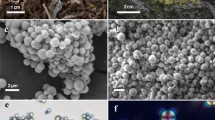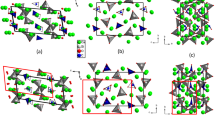Abstract
CONFLICTING reports have been published for the position of the calcite–aragonite phase transition, and two factors contributing to this are the slow solid state reaction kinetics1 and the problems of quenching the stable assemblage2. Bell and England2 concluded from their experiments that aragonite which formed stably within a wide pressure range (above 600° C) inverted to calcite during the quench. We have recently extended the phase relationships involving a liquid phase in the system calcium oxide–carbon dioxide–water from 4 kbars pressure3,4 to 40 kbars5 using a piston-and-cylinder high-pressure apparatus. The liquids in this system are very reactive media, and no problems have been encountered in reaching equilibrium in this and a variety of related systems6. Across the calcite–aragonite boundary, the ternary phase assemblage calcite + liquid + vapour undergoes a transition to aragonite + liquid + vapour. In runs completed at pressures well above and well below the phase boundary, aragonite and calcite crystals in the quenched assemblage calcium carbonate + liquid + vapour were positively identified by X-ray and optical properties. The morphology of aragonite crystals coexisting with the ternary liquid is distinct from that of the calcite crystals, and the original shape of the equilibrium phase, aragonite or calcite, becomes frozen into the surrounding liquid during the quench and is thus preserved for microscopic examination. The shape of the carbonate crystals in the quenched assemblage calcium carbonate + liquid + vapour was therefore used to bracket the calcite–aragonite transition boundary down to the solidus temperature at 580° C. X-ray powder diffraction and refractive-index measurements demonstrate that crystals with the morphology of aragonite, in runs close to the transition boundary, have inverted to complexly twinned, biaxial calcite with optic axial angles ranging from near zero up to an estimated 20° (2V for aragonite is 18°). The implications of this observation have been discussed elsewhere7.
This is a preview of subscription content, access via your institution
Access options
Subscribe to this journal
Receive 51 print issues and online access
$199.00 per year
only $3.90 per issue
Buy this article
- Purchase on Springer Link
- Instant access to full article PDF
Prices may be subject to local taxes which are calculated during checkout
Similar content being viewed by others
References
Davis, B. L., and Adams, L. H., J. Geophys. Res., 70, 433 (1965).
Bell, P. M., and England, J. L., Ann. Rep. of the Director of the Geophys. Lab., Carnegie Institution, Washington, D.C., 63, 176 (1964).
Wyllie, P. J., and Tuttle, O. F., J. Petrol., 1, 1 (1960).
Wyllie, P. J., and Raynor, E. J., Amer. Min., 50, 2077 (1965).
Boettcher, A. L., and Wyllie, P. J., Trans. Amer. Geophys. Union (in the press) (1967).
Wyllie, P. J., in The Carbonatites, edit. by Tuttle, O. F., and Gittins, J. (Wiley-Interscience, 1967).
Boettcher, A. L., and Wyllie, P. J., Amer. Min. (in the press) (1967).
Boeke, H. E., Neues Jahrb. Min. U. Geol., 1, 91 (1912).
Bridgman, P. W., Amer. J. Sci., 237, 7 (1939).
Crawford, W. A., and Fyfe, W. S., Science, 144, 1569 (1964).
Jamieson, J. C., J. Geol., 65, 334 (1957).
Brown, W. H., Fyfe, W. S., and Turner, F. J., J. Petrol., 3, 566 (1962).
Coleman, R. G., and Lee, D. E., Amer. J. Sci., 260, 577 (1962).
McKee, B., Amer. Min., 47, 379 (1962).
Vance, J. A. (personal communication).
Author information
Authors and Affiliations
Rights and permissions
About this article
Cite this article
BOETTCHER, A., WYLLIE, P. Revision of the Calcite–Aragonite Transition, with the Location of a Triple Point between Calcite I, Calcite II and Aragonite. Nature 213, 792–793 (1967). https://doi.org/10.1038/213792a0
Issue Date:
DOI: https://doi.org/10.1038/213792a0
This article is cited by
-
Blueschist: A window into high-pressure/low-temperature metamorphism and subduction zone dynamics
Science China Earth Sciences (2020)
-
A differential thermal analysis study of the high-temperature polymorphism of calcite at high pressure
Contributions to Mineralogy and Petrology (1976)
-
The stability of staurolite and chloritoid and their significance in metamorphism of pelitic rocks
Contributions to Mineralogy and Petrology (1969)
Comments
By submitting a comment you agree to abide by our Terms and Community Guidelines. If you find something abusive or that does not comply with our terms or guidelines please flag it as inappropriate.



